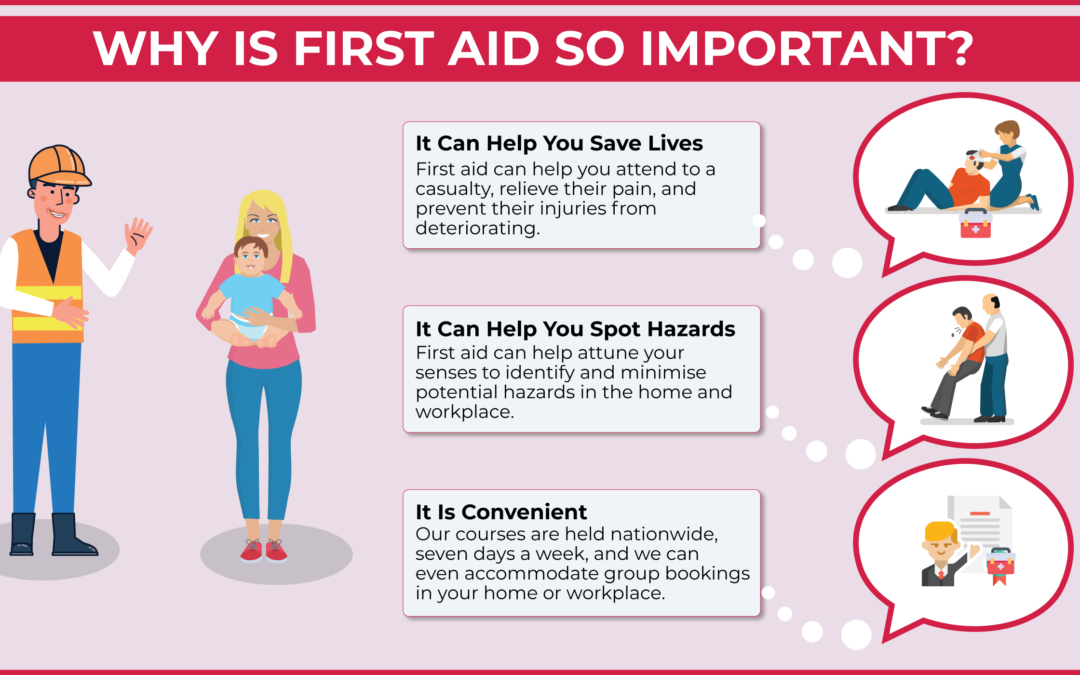Why Every Business Should Invest in First Aid Training
Introduction
Why Every Business Should Invest in First Aid Training. Investing in first aid training is not just a legal obligation for businesses; it is a crucial step toward creating a safer, more responsive workplace. Proper first aid training equips employees with the skills and knowledge necessary to handle emergencies efficiently, mitigating risks and enhancing overall workplace safety. This article explores the compelling reasons why every business should prioritize first aid training.
Enhancing Workplace Safety
1. Immediate Response to Injuries
In any workplace, accidents and medical emergencies can occur unexpectedly. First aid training ensures that employees are prepared to respond promptly to injuries, from minor cuts and bruises to more serious incidents. This immediate response can prevent minor injuries from worsening and can stabilize individuals until professional medical help arrives.
2. Reducing the Severity of Injuries
Effective first aid can significantly reduce the severity of injuries. Trained employees know how to manage bleeding, administer CPR, and handle various types of trauma. By addressing injuries quickly and correctly, businesses can minimize the impact of accidents, potentially saving lives and reducing recovery times.
3. Creating a Safer Work Environment
Investing in first aid training demonstrates a commitment to workplace safety. It helps to foster a culture of preparedness and responsibility, where employees feel valued and protected. This proactive approach contributes to a safer work environment, reducing the likelihood of accidents and ensuring that everyone knows how to respond in emergencies.

Why Every Business Should Invest in First Aid Training
Compliance with Legal Requirements
1. Meeting Regulatory Standards
Many jurisdictions have legal requirements regarding workplace safety and first aid. For instance, regulations often mandate that businesses have trained first aid personnel on site. By investing in first aid training, businesses ensure they comply with these regulations, avoiding potential fines and legal issues.
2. Avoiding Legal Liabilities
Failure to provide adequate first aid training can result in legal liabilities if an incident occurs and it is found that the business was not prepared. Investing in training helps to mitigate these risks by demonstrating that the business has taken reasonable steps to ensure the health and safety of its employees.
3. Enhancing Insurance Coverage
Some insurance policies may offer better coverage or lower premiums for businesses that have implemented comprehensive safety measures, including first aid training. By investing in training, businesses can potentially benefit from improved insurance terms and reduce the financial impact of workplace accidents.
Boosting Employee Confidence and Morale
1. Empowering Employees
First aid training empowers employees by providing them with the skills to handle emergencies effectively. This empowerment boosts their confidence in managing potentially life-threatening situations, enhancing their sense of security and competence within the workplace.
2. Improving Job Satisfaction
Knowing that they are well-prepared to respond to emergencies can improve employees’ job satisfaction. It creates a supportive work environment where employees feel valued and cared for. This positive environment can lead to increased morale and a more engaged workforce.
3. Fostering Team Cohesion
First aid training often involves collaborative exercises and simulations. These activities not only improve first aid skills but also foster teamwork and communication among employees. Strengthening these relationships can lead to better cooperation and a more cohesive work environment.
Preparing for Emergency Situations
1. Effective Emergency Response
In emergencies, every second counts. First aid training prepares employees to act swiftly and effectively, providing critical care during medical incidents. This preparedness ensures that the business can handle emergencies efficiently, reducing the risk of complications and improving overall outcomes.
2. Implementing Emergency Protocols
Training helps employees understand and implement emergency protocols and procedures. Knowing how to evacuate a building, respond to fires, or manage other emergencies ensures that employees can act according to established procedures, enhancing the overall safety and efficiency of the response.
3. Managing Specific Workplace Risks
Different workplaces have unique risks and hazards. First aid training can be tailored to address specific workplace risks, such as chemical spills, machinery accidents, or health emergencies related to the industry. Customized training ensures that employees are prepared to handle the particular challenges of their work environment.
Improving Business Continuity
1. Minimizing Downtime
Accidents and emergencies can disrupt business operations. By having trained first aid personnel on site, businesses can manage incidents more effectively, reducing downtime and maintaining operational continuity. This preparedness ensures that the business can continue functioning smoothly, even during emergencies.
2. Supporting Crisis Management
First aid training is an integral part of crisis management plans. It helps businesses develop comprehensive strategies for handling emergencies, including first aid response. Effective crisis management supports business resilience and stability, ensuring that the organization can navigate and recover from incidents more efficiently.
3. Enhancing Reputation and Trust
A business that prioritizes first aid training demonstrates its commitment to employee well-being and safety. This commitment enhances the business’s reputation and fosters trust among employees, clients, and stakeholders. A positive reputation for safety and preparedness can also be a competitive advantage in attracting and retaining top talent.
Choosing the Right First Aid Training
1. Assessing Business Needs
Determine the specific first aid training needs based on the nature of your business, the potential risks, and the size of your workforce. This assessment will help in selecting the most appropriate training course and ensuring that it meets the requirements of your workplace.
2. Selecting Accredited Providers
Choose training providers that are accredited and recognized by relevant authorities. Accredited courses adhere to industry standards and provide high-quality training that meets regulatory requirements.
3. Implementing Ongoing Training
First aid skills can become outdated, so it’s important to implement a schedule for ongoing training and refresher courses. Regular updates ensure that employees remain current with the latest practices and guidelines, maintaining a high level of preparedness.
Conclusion
Investing in first aid training is a critical step for every business. It enhances workplace safety, ensures compliance with legal requirements, boosts employee confidence and morale, and improves emergency preparedness. By selecting the right training and implementing ongoing education, businesses can create a safer, more resilient work environment, ultimately benefiting both employees and the organization as a whole. Prioritizing first aid training demonstrates a commitment to employee well-being and safety, contributing to a positive and productive workplace.

